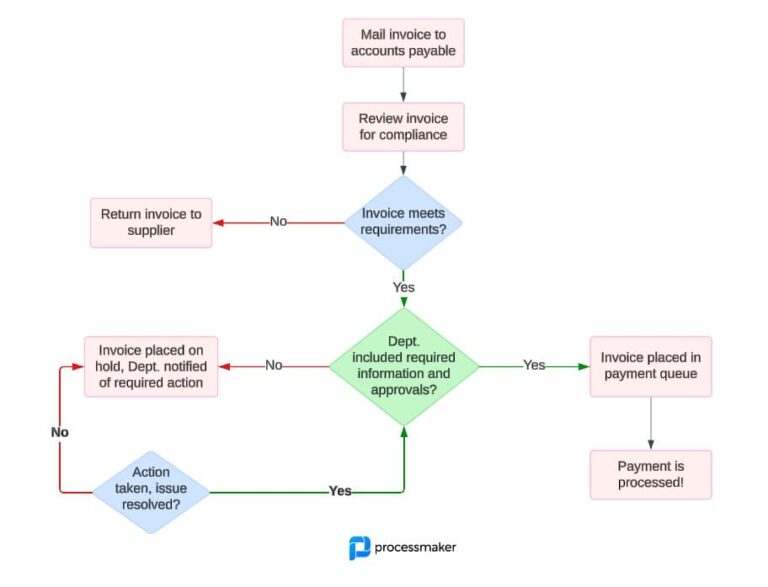Process automation is the act of digitizing a process to accomplish a task or workflow swiftly. The term “business process automation” is also often used interchangeably with process automation.
Many business processes can be fully-or-partially automated with human interaction at strategic points. Whether in marketing, supply chain, IT, accounting, or sales – all can benefit from digital process automation (DPA). In fact, Forrester has found that 73 percent of consumers say that they base a company’s customer service rating on how well they value their time.
But what is DPA exactly? Well, it isn’t a single unit of technology. In contrast to business process management (BPM) and robotic process automation (RPA), DPA connects different technologies to approach automation holistically – from start to finish. If you’re ready to implement DPA, try our six key factors to success.
1. Visualize and improve business processes
When we first introduce a new process, we specify the steps that must be completed to achieve the desired result. But over time, the process will change, often for good reasons. However, this organic development of processes makes process flow documentation inaccurate and out of date. Should management wish to analyze the process to determine whether it can be improved, there’s no clear picture of the status quo.
When digital process automation is deployed well, it helps organizations work smarter. Let’s start with the creation of a business process. To begin, you have to define which steps must be taken to achieve your objective. However, the business process can change over time. When a cycle is modified, it’s crucial to document the updated steps and determine areas for improvement. Manual documentation is highly inefficient and severely prone to human error. On the other hand, process management software can record every change in real-time. So then, every stakeholder understands where they are even when significant changes have been made.
There isn’t any question that agility provides a competitive edge in a continually-evolving marketplace and business environment. DPA utilizes design-thinking methodologies and real-time intelligence to construct better processes, which then provides better experiences for both customers and employees.
Using DPA to set up and test your business processes improves predictability and management of organizational outcomes. As a result, even the most complicated process flows garner improved adaptation.
2. Deploy digital process automation in every department
DPA is vital to end-to-end transformation. Every department must collaborate to reach shared business objectives in the always-on world – this is especially true in a remote work environment. When employees have an issue with a process, DPA enables this form of communication so every associated stakeholder can see precisely where their assistance is needed. Departments can no longer work in silos, and the good news is DPA unifies various systems and resources to facilitate business-wide digital transformation. Not only does this incorporate agility into legacy technologies, but it enhances the customer focus and enables end-to-end automation.
3. Go frictionless
Front-end customer experiences can make or break your company’s reputation. As such, it’s imperative to deliver relevant customer experiences consistently. At the same time, you can’t afford to ignore the critical back-end systems either.
The question is this: How do you efficiently manage the front-end and back-end without adding new channel silos and friction? The last thing you need is to increase the data gap between new and legacy apps. If your infrastructure is fractured, it makes it even more difficult to deliver the frictionless experiences your clients expect. You don’t have to trade one for the other when you use DPA, as it can seamlessly connect systems on both ends of the business spectrum. No more friction means unlimited opportunities. Although, you will have to spend some time thinking about how you can link your processes to deliver enhanced outcomes.
4. Empower your citizen developers
There is an immediate need to automate processes in the digital age along with a growing demand for app development. Further, any business with limited resources and limited IT personnel can already feel the overwhelming pressure. Just ask your HR manager how difficult and costly it is to hire skilled engineers and developers. Building an app, whether it is simple or complex, should be easy.
Thankfully, you can find respite with low-code application development platforms. Your employees can become citizen developers without any coding training or experience. Business users can work collaboratively with IT to design and upgrade business-specific applications such as deploying process rules, requirements, deployment, and even customer offers. DPA offers both the technology and the methodology to address your customer’s expectations in the digital era. We recommend rethinking your processes by putting the customer first, and then integrating automation to ensure those journeys are realized.
5. Remember the analytics
When digital process automation captures processes in real-time, you can also get detailed analytics to find patterns of failure and figure out the why’s and how’s. Instead of manually analyzing countless blocks of data, management can immediately recognize areas ripe for improvement. You see, DPA is an end-to-end approach. What does that mean? It means you get to add design thinking to your process. You’re not just worried about the individual tasks; you can reimagine the process from execution to finish with the desired outcome guiding your overall design.
6. Use AI for operational intelligence
DPA operates on a single and unified platform. When application changes are necessary, you can manage the modifications without disrupting the process. Regardless of the task at hand, it is vital to achieving results rapidly. As a result, low-code is essential for bringing new processes to life. What does AI have to do with any of these process aspects? Well, AI can locate the bottlenecks and report how they impact the business outcome. Besides, AI can ensure every step is efficiently allocated, whether it be automation or human works or both.
You can use reliable operational intelligence to eliminate time-consuming tasks and the costly “rip and replace” approach. Instead, you can “refresh” your legacy systems so that they work in conjunction with new applications yielding seamless and long-term results.
In conclusion
Processmaker combines digital process automation technology with design-thinking to improve customer experiences, incorporate end-to-end digital transformation, and boost time to market. DPA makes your organization and your employees more effective and competitive. Are you ready to take your company to the next level? Contact Processmaker today to learn how.




